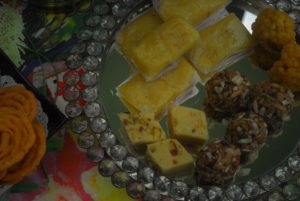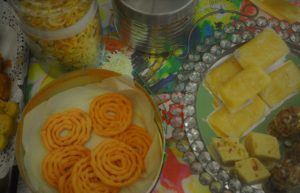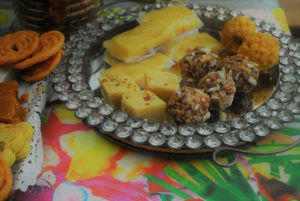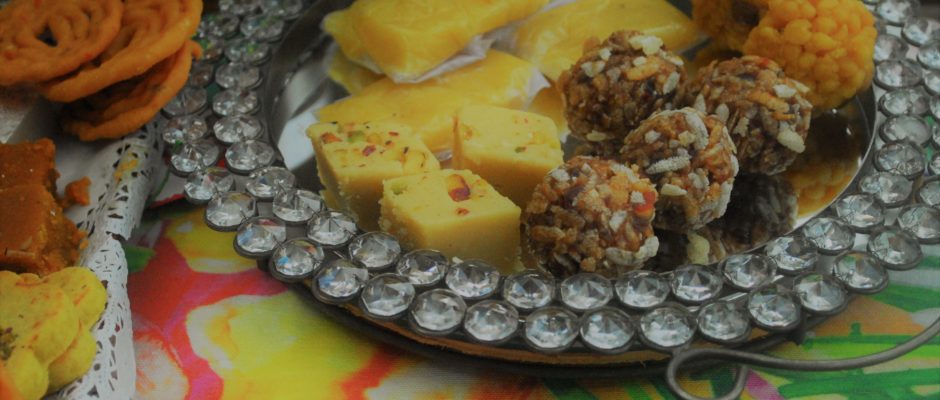Simplicity Coimbatore ,Deepavali palagaram
One bite of the soft , yellow boondi ladoo and it was like I was a kid all over again. My grandaunt was skilled at making the softest of boondi ladoos and she is often in our thoughts.The entire family would wait for her to make this much sought after sweet and eagerly look forward to eating them. The gram flour would be almost coaxed into forming light as air globes of boondhi ,delicate strands of saffron, plump raisins and (my favourite) square pieces of kalkandhu would be added before being gathered together in the palm of the hand to form spherical ladoos which were held together firmly and yet not squeezed to such an extent that the boondhi lost it’s shape. We realised then as we acknowledge now that she was a culinary wizard who went about her day barely acknowledging her skills! As the next generation of children came along, we cousins had to share this delicious palagaram with our offspring. I remember selfishly hoping that they may not like it as much but (sadly) they seemed to love it a whole lot more ! Since then I have been gracious enough to willingly share what came my way.
Decades of childhood memories like these are what continue to make festivals like Deepavali so important for me. The need to reach out to family , to gather around, to share a meal , to laugh mindlessly , dress up ,celebrate and create more memories is something which we look forward to year after year. While it is vital to give to the needy ,it is also important to be thankful and celebrate what we do have ,without guilt. When a few friends spoke about abstaining from Deepavali sweets this year I marveled at their will power and self control. I agree we are living in times of excess and there must be a balance.

My grandmother used to send us grandchildren each ,a generous portion of adhirasam dough. Today that is a precious memory which my cousins and I cling on to ,having lost her a few weeks ago.So now these traditional sweets and savouries have taken on a whole new meaning in my life. I am so grateful for the presence of the elders who continue to go through the painstaking process of making these sweets in the same manner year after year.
For the longest time, the jalebis, ladoos, mysore pak,suryakala, badhushah etc were available to us only during Deepavali.I remember a time when my mother and aunts would decide on what sweets they were making and hire a cook (well in advance) who was an expert at making these different traditional sweetmeats.But it would be made under their watchful eye so that nothing was wasted or done in haste. They would then go through the process of packing it to send to loved ones. In those days there was even a separate kitchen and utensils, at the back of the house meant only for making sweets and savouries during the festival. So if one didn’t eat these Indian sweets at Deepavali , then it was most likely that it wouldn’t be available until the next year (not the homemade ones at least)

Today with mithai shops opening everywhere, not only has the palagaram intake become a regular affair but the skills required for making these home made treats are not being passed on to the next generation. I would rather abstain from or drastically cut down on palagaram consumption throughout the year just to be able to enjoy it during the festive season when it is at it’s best!
A sister-in-law of mine began to get murukku cravings a few days ago and quickly got some hand made for all of us. For me ,there’s no other time that a kara boondhi mixture tastes as good as it does during Deepavali. When it also has little bits of dough deep fried in a diamond shaped ,that’s what we lot consider an ‘authentic mixture’.
We are all so conscious of eating mindfully as a result of which my Deepavali goodies have included gifts of thoughtfully sourced honey , relishes, cheese platters,teas and dry fruits which will be made good use of throughout the year.
But in all honesty I dread to think of a Deepavali without these home made sweets which make up a huge part of our cultural food heritage.We don’t have to eat the whole lot but we can certainly eat one each ,the way palagaram was originally intended to be enjoyed (by sharing)

The jalebi from my mother’s house is missing from my table this year and it’s a good way to not only keep in mind the family member we have lost recently but also to be immensely thankful for who all we are surrounded by in the present.
As I help myself to a badam halwa,rather than think of the sugar and ghee ,it’s so much nicer to think of the person who sent it and their labour of love. If we didn’t have all of this, neither would we have stories of when cousins ate the adhirasam dough in it’s raw form thinking it to be halwa (true story)! With all the love that went into making that dough no one fell sick!
So keep the kai muruku , the thattai muruku,the mullu murukku and all the rest of it coming. After all this too is a celebration of who we are !


No comments yet.